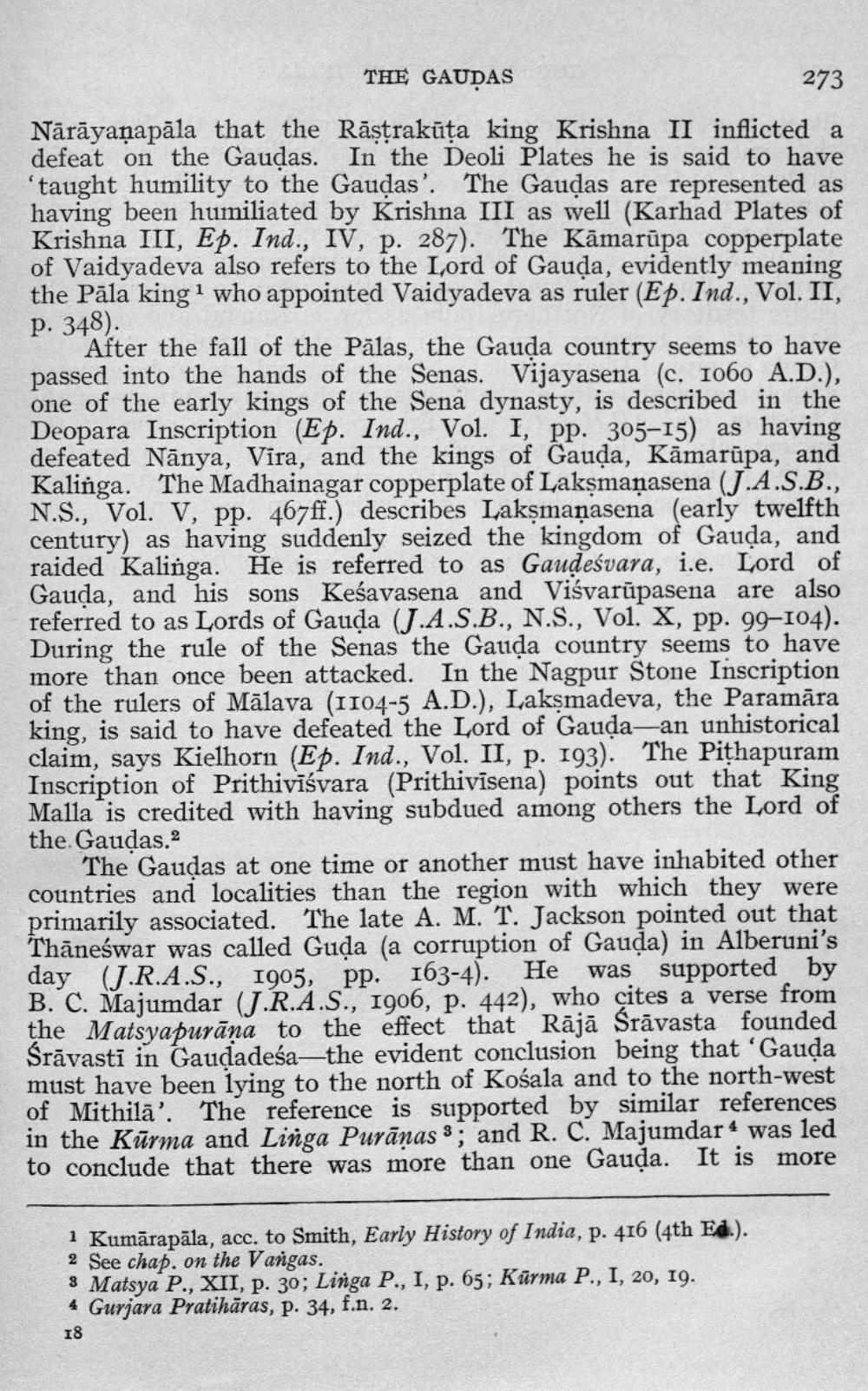________________
THE GAUDAS
273 Nārāyaṇapāla that the Rāstrakūta king Krishna II inflicted a defeat on the Gaudas. In the Deoli Plates he is said to have taught humility to the Gaudas'. The Gaudas are represented as having been humiliated by Krishna III as well (Karhad Plates of Krishna III, Ep. Ind., IV, p. 287). The Kāmarūpa copperplate of Vaidyadeva also refers to the Lord of Gauda, evidently meaning the Pāla king 1 who appointed Vaidyadeva as ruler (Ep. Ind., Vol. II, p. 348).
After the fall of the Pālas, the Gauda country seems to have passed into the hands of the Senas. Vijayasena (c. 1060 A.D.), one of the early kings of the Sena dynasty, is described in the Deopara Inscription (Ep. Ind., Vol. I, pp. 305-15) as having defeated Nānya, Vira, and the kings of Gauda, Kāmarūpa, and Kalinga. The Madhainagar copperplate of Lakşmaņasena (J.A.S.B., N.S., Vol. V, pp. 467ff.) describes Lakşmaņasena (early twelfth century) as having suddenly seized the kingdom of Gauda, and raided Kalinga. He is referred to as Gaudeśvara, i.e. Lord of Gauda, and his sons Keśavasena and Viśvarūpasena are also referred to as Lords of Gauda (J.A.S.B., N.S., Vol. X, pp. 99–104). During the rule of the Senas the Gauda country seems to have more than once been attacked. In the Nagpur Stone Inscription of the rulers of Mālava (1104-5 A.D.), Lakşmadeva, the Paramāra king, is said to have defeated the Lord of Gauda-an unhistorical claim, says Kielhorn (Ep. Ind., Vol. II, p. 193). The Pithapuram Inscription of Prithivīśvara (Prithivisena) points out that King Malla is credited with having subdued among others the Lord of the. Gaudas.2
The Gaudas at one time or another must have inhabited other countries and localities than the region with which they were primarily associated. The late A. M. T. Jackson pointed out that Thāneswar was called Guļa (a corruption of Gauda) in Alberuni's day (J.R.A.S., 1905, pp. 163-4). He was supported by B. C. Majumdar (J.R.A.S., 1906, p. 442), who cites a verse from the Matsyapurāna to the effect that Rājā Srāvasta founded Srāvasti in Gaudadeśa—the evident conclusion being that 'Gauda must have been lying to the north of Kośala and to the north-west of Mithilā'. The reference is supported by similar references in the Kūrma and Linga Purānas 3; and R. C. Majumdar 4 was led to conclude that there was more than one Gauda. It is more
1 Kumārapāla, acc. to Smith, Early History of India, p. 416 (4th Ed.). 2 See chap. on the Vargas. 3 Matsya P., XII, p. 30; Linga P., I, p. 65; Kūrma P., I, 20, 19. 4 Gurjara Pratihāras, p. 34, f.n. 2.
18




